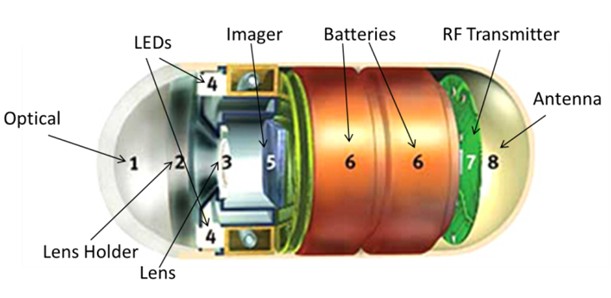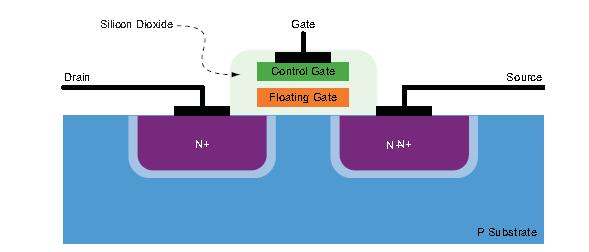Medical device system designers face a number of problems, including system reduction, increased functionality, and extended battery life of implantable body devices while ensuring safety through optimal safety, reliability, and efficacy. Designers must also consider the effects of single event inversion (SEU) caused by ionizing radiation in devices used in radiation therapy environments, as this can lead to dangerous configuration changes. Miniaturization has become a major growth driver for life-critical devices such as implantable cardioverter defibrillators (ICDs) and heart rate management (CRM) products. One way to reduce the volume is to ensure that radio frequency (RF) technology used to improve the functionality of medical devices consumes very low power, so smaller batteries can be used. Figure 1 shows this technique applied to the Pillcam Wireless Endoscopic Imaging Capsule from Given Imaging Ltd. The product uses a custom RF transceiver from Microsemi, Inc., which reduces battery size by enabling capsule power below 7.5mW while propagating up to 14 images per second during 8 hours of operation. The use of chip-on-board components, chip-on-chip, and more advanced space-efficient semiconductor packaging technologies such as the latest 2-D and 3-D packages can also reduce device size. These packaging technologies reduce the overall circuit space of heart rate management (CRM) devices by up to 80%. One of the most effective techniques is the stacked-die approach, which reduces interconnect length and resistance while increasing yield. Die stacking allows designers to combine multiple wafer processing technologies in a small footprint while improving test access. The Thin Interconnected Package Stack (TIPS) project has made great strides in the next generation of stacked chip solutions. The project was invested by the nanoelectronics research institute IMEC R&D in partnership with companies and social organizations. A packaging method that reduces the height of the device and other dimensions while having the advantages of a single module is provided. Field-programmable gate array (FPGA) devices are also an important contributor to device miniaturization. For example, traditional designers have been using microcontrollers, application-specific standard products (ASSP) chips, and small programmable logic devices to build portable medical devices. Human Machine Interface (HMI) and Micro Motor Controller. Not only is this method difficult to reduce the size of the device, but it is also not suitable for optimizing the number of channels for critical sensors and actuators. Conversely, FPGA-based solutions are ideal for adding more functionality to a smaller package size, meeting the requirements of devices that require a small form factor. They also offer the added benefit of allowing users to upgrade their designs, thereby supporting new standards or providing more functionality. FPGA devices also help reduce power consumption compared to alternative solutions. For example, liquid crystal display (LCD) panels in portable medical devices consume half the power of the application's power budget. The solution is to design the system so that the LCD and control logic are placed in power-saving mode as much as possible, greatly reducing battery consumption. This method of using FPGA is very simple, but because the design of the spot ASSP product does not consider the requirements of the medical market, it is difficult to implement the spot ASSP product. Today's Flash-based FPGA devices also offer important built-in security features to ensure that only legitimate upgrades can be implemented, as well as other important security issues. Today's medical devices are at risk of theft, forgery, aftermarket tampering and overbuilding, and subcontractors have created more than the number of equipment orders, so the remaining equipment can be sold. Each of these risks can have serious consequences for the medical device market. Imagine a scenario where the wrong software is downloaded into an insulin pump or a counterfeit component is used in the design. In either case, the insulin pump may cause an inaccurate dose and cause serious injury to the patient. Protecting medical equipment from tampering requires both hardware and software checks, otherwise consumers may restore factory settings before claims and there is no way to detect attacks. Computer hackers have the potential to modify the functionality of services and infrastructure to further hamper attack detection, response, and enforcement countermeasures. The use of anti-fuse and flash-based FPGA devices is important because they are very difficult to reverse engineer with SRAM-based FPGAs. Once programmed, the flash-based FPGA retains all programming information on-chip. Since the programming unit is non-volatile, it is possible to maintain state between power-up cycles. In contrast to SRAM-based FPGAs, SRAM-based FPGAs must reload configuration data on power-up to expose the programming bitstream to potential hackers. The only way for a hacker to intercept a flash-based FPGA bitstream is from a configuration file for field device upgrades. However, this can be prevented by encrypting in the FPGA device and using flash memory to permanently store all encryption keys and settings. Finally, designers of equipment used in radiation therapy environments must ensure that the device is immune to dangerous SEU events, and SEU events occur when high-energy particles or ions impact the NP junction dissipation zone. Charges from femtocoloumb to picocoloumb accumulate in this region, causing voltage and current transients. Using SRAM-based FPGAs, the linear energy transfer (LET) obtained is sufficient to supply excess energy to the NP junction and cause SEU events in the form of memory components (SRAM cells, registers, latches, or triggers). State change (bit flip). For flash memory cells, the situation is quite different. Flash is a non-volatile memory structure that includes a floating gate between the control gate and the lower MOSFET structure, packaged in a good dielectric (see Figure 2). It still deposits charge when the ion attacks or approaches the flash cell dissipation region. However, the critical charge amount (QCRIT) required for the flash cell memory bit flip is much larger than the SRAM cell, and the flash cell used for configuration also has a very robust structure. Therefore, flash units for FPGA configuration have SEU event immunity. Miniaturization is becoming increasingly important for medical devices, and designers must provide better functionality, battery life, and safety, which requires optimal safety, reliability, and efficacy. The latest FPGA technology combines ultra-low power chip design with advanced packaging technology to help significantly reduce device size. Compared to alternative methods, more functionality can be put into a smaller space while improving efficiency. Choosing flash-based FPGA technology can simultaneously reduce the risk of fatal security vulnerabilities while providing SEU immunity for devices used in radiotherapy environments. Author: Senior Vice President of Microsemi's Communications and Medical Products (CMPG) / General Manager Stephen J. Swift Stepper motors are known for their accurate positioning capabilities and high torque delivery at low speeds, but they require careful sizing to ensure the motor matches the load and application parameters, to minimize the possibility of lost steps or motor stalling. Adding a gearbox to a Stepper Motor system can improve the motor`s performance by decreasing the load-to-motor inertia ratio, increasing torque to the load, and reducing motor oscillations. Geared stepper motor,Stepper motor gear reduction,Small geared stepper motor,High torque geared stepper motor,Geared stepper motor with encoder,gear stepper motor with driver Shenzhen Maintex Intelligent Control Co., Ltd. , https://www.maintexmotor.com
Figure 1: Pillcam Wireless Endoscopy Capsules 
Figure 2: Flash memory unit